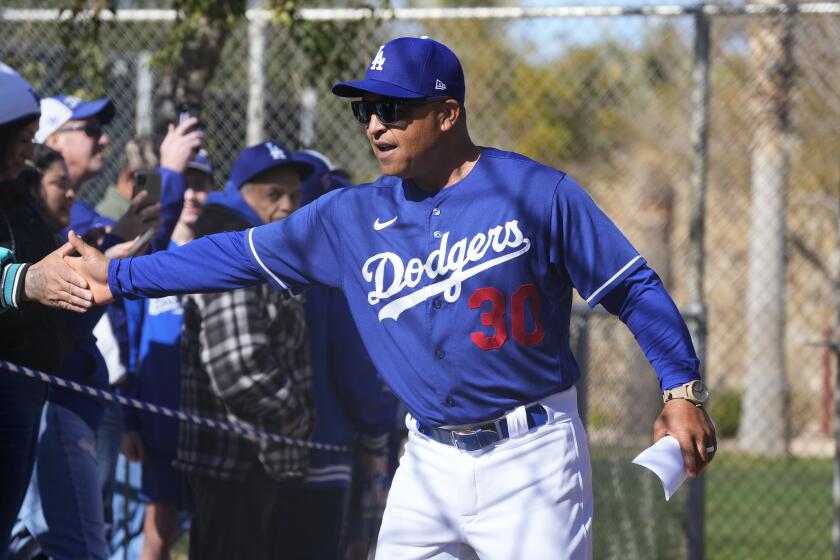Jorge Castillo is a sports enterprise reporter, with a focus on baseball, for the Los Angeles Times.
1
Clayton Kershaw and Miguel Cabrera have résumés few other baseball players have ever matched. Both are former MVPs and future first-ballot Hall of Famers. Kershaw has three Cy Young Awards. Cabrera has won a Triple Crown and surpassed both 500 home runs and 3,000 hits for his career.
This offseason, both players committed to playing in the World Baseball Classic for their respective countries. Kershaw’s commitment to play for Team USA was considered a coup for a tournament still seeking to establish legitimacy. Without Cabrera, arguably the greatest Venezuelan baseball player ever, the tournament would’ve left a baseball-mad nation unsatisfied.
Both encountered an obstacle earlier this month: securing insurance coverage to participate in the event. Kershaw’s and Cabrera’s contracts, which both expire after this season, were deemed uninsurable because of their injury histories.
Dodgers pitcher Clayton Kershaw won’t play in the World Baseball Classic because of an insurance issue. The WBC must fix these issues in order to grow.
Cabrera was informed he wasn’t insured and therefore couldn’t participate but was cleared to play days later. On the other hand, Kershaw begrudgingly announced Friday he won’t pitch for Team USA without delving into the details, though citing there were “complications” and “all sides really tried to make it work.”
The difference? The Detroit Tigers made the unusual decision to waive Cabrera’s insurance requirement and assume the financial risk should Cabrera get hurt playing in the tournament, according to people with knowledge of the situation not authorized to speak publicly on the matter. The Dodgers did not do that for Kershaw.
Kershaw’s announcement not only spawned disappointment but created confusion. Here are answers to clarify a few questions:
2
Why is insurance necessary?

Detroit Tigers star Miguel Cabrera points during an at-bat in July. The Tigers are making it possible for Cabrera to play in the WBC by assuming the financial risk should he get hurt.
(Carlos Osorio / Associated Press)
Cabrera, 39, is in the final year of an eight-year, $248-million contract. He is slated to make $32 million this season before retiring.
Kershaw, who turns 35 next month, signed a one-year, $20-million deal in December. He has not closed the door on retiring after the season, but the Dodgers are relying on Kershaw to top their rotation alongside Julio Urías as they again compete for a World Series title.
For Cabrera, the circumstances are different. He’s the designated hitter for a rebuilding Tigers club that isn’t expected to contend for a playoff spot after going 66-96 last season.
They are just two of the players on huge contracts who committed to play in the WBC this year.
The company that owns Bally Sports is expected to file for bankruptcy, a move that could result in a huge financial hit for the Angels and 13 other MLB teams.
While Major League Baseball and the players’ association want the WBC to thrive, believing a star-studded tournament produces substantial long-term benefits for the sport, teams are understandably more concerned about the short term. There’s a 162-game season to play after the event. The tournament’s timing — the final will be played eight days before opening day — leaves clubs queasy.
Insurance softens the potential blow. Players are paid their guaranteed salaries no matter what, whether they miss the entire season or a few games because of an injury sustained in the WBC.
The insurance coverage — which goes through NFP — protects teams from having to pay a player for time missed because of an injury stemming from the tournament. If an injury is determined to have happened in the WBC, then the team is reimbursed for the time the player misses. WBC participants are required to undergo entrance and exit physicals to help glean injury information.
3
What does the data say about injury risk?

(Ross D. Franklin / Associated Press)
MLB has compiled injury data from the first four WBC iterations, according to a league official. The data aren’t publicly available, but the official maintained “there is no correlation between being hurt and playing in the WBC.” It’s also in MLB’s best interest to say that without sharing the data.
A study conducted by Washington University in 2017, days after the previous WBC was held, determined that tournament participants missed an average of 2.35 more days because of injury after the WBC. For pitchers, it was a 4.07-day uptick. Position players missed less than one day more.
These are small sample sizes — too small to convince teams that there isn’t a risk.
“For me, it’s tempered in the sense that if they’re going to get hurt, they’re going to get hurt,” Dodgers manager Dave Roberts said. “I don’t worry about it if I can’t control it. It’s not out of sight, out of mind. But they want to perform, they want to compete and I’m not going to deter them.
“So, I’m just going to kind of keep my fingers crossed and hope for the best. But as long as you’re playing baseball, there’s always a chance of injury. “
Dodgers manager Dave Roberts has been a beacon of positivity in spring training, rediscovering his love for the team after last year’s playoff meltdown.
4
How does this insurance arrangement work?

Dodgers relief pitcher Brusdar Graterol is another player who won’t be competing in the World Baseball Classic because of insurance issues.
(Marcio Jose Sanchez / Associated Press)
This particular arrangement covers players on 40-man MLB rosters — other leagues that have players in the tournament are not included. Free agents don’t need insurance because they’re not on an MLB roster.
One premium is negotiated with NFP to cover every player. An underwriter reviews each player’s medical records. Players are then placed into two buckets: insurable under that one umbrella premium or uninsurable.
Players can be rendered uninsurable for “four or five” reasons, according to a person with knowledge of the situation. One is that the player has a “chronic condition” based on his injury history. Another is that the player spent considerable time on the injured list the previous season or finished the previous season on the injured list.
Kershaw and Cabrera fell into the “chronic” category.
Kershaw’s injury history includes a significant elbow injury in 2021 and various back ailments over the last decade. Kershaw landed on the 10-day injured list twice last season — both times because of back issues. Cabrera has dealt with left biceps injuries over the last four seasons and various other nagging ailments.
Follow along for the latest news and analysis from Dodgers spring training at Camelback Ranch in Phoenix ahead of the 2023 MLB season.
Dodgers reliever Brusdar Graterol wanted to pitch in the tournament for Venezuela, but he wasn’t offered insurance coverage because of previous injuries. Texas Rangers pitcher Nathan Eovaldi committed to Team USA but was left off the roster because he didn’t meet the criteria for insurance coverage. The same happened in 2017 with pitcher Sonny Gray, who didn’t play for the U.S. after spending 70 days on the injured list in 2016.
Teams also have the option to not allow a player to participate in the tournament if he was on the 60-day injured list at any point during the previous season.
St. Louis Cardinals outfielder Tyler O’Neill faced that hurdle this month. O’Neill was deemed ineligible to play for Canada after finishing last season on the injured list, but the Cardinals waived the withhold and cleared him with a physical before the insurer authorized coverage.
5
Can players explore other insurance avenues?
Yes. Kershaw explored other ways to obtain an insurance claim, even considering a personal policy for the event, but couldn’t find a solution.
One agent described a player taking out his own insurance for the tournament as “so damn expensive.” It’s not believed to have ever been done for the WBC. Although Kershaw tried, he’ll have to watch the tournament from Camelback Ranch.













